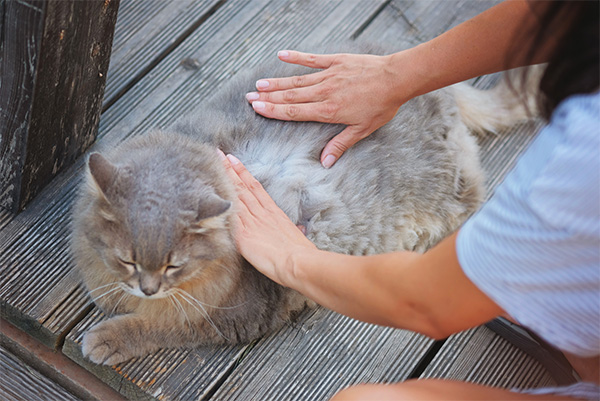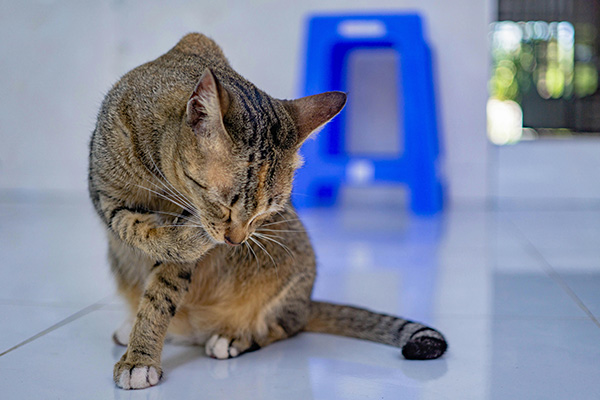Cat fleas are a persistent issue for cats and their owners. These tiny insects, especially the Ctenocephalides felis, survive by feeding on blood, leading to itching, skin irritation, and even hair loss from persistent scratching. Fleas can cause serious health issues like flea allergy dermatitis, anemia in young kittens, and tapeworm infestations.
In this guide, we cover identifying flea infestations, treating fleas with safe flea control products, and preventing future outbreaks. Regular flea prevention is essential for both indoor and outdoor cats, helping them remain healthy and comfortable year-round.
What are Fleas?
Fleas are small, wingless parasites that thrive on the blood of mammals, making them a widespread and ongoing issue for cats. The most common species affecting cats is Ctenocephalides felis, or the cat flea. These pests thrive in warm, humid environments, enabling them to infest homes and pets with ease. Fleas are equipped with impressive jumping abilities, allowing them to transfer between hosts quickly and contributing to their rapid spread.
Flea Life Cycle

Comprehending the flea life cycle is crucial for successful flea control and prevention. Fleas progress through four stages, each of which requires specific treatment approaches to break the cycle and get rid of fleas entirely:
Egg: Female fleas lay eggs on the host, which often fall off into the environment, like carpets or bedding, where they mature. One flea can produce hundreds of eggs, resulting in a rapid infestation if not addressed.
Larva: Flea eggs hatch into larvae, which feed on organic material, including flea dirt (flea feces containing blood meal residue). At this stage, flea larvae are difficult to see but can quickly spread within the home.
Pupa: The larvae create cocoons and transition into the pupa stage. Flea pupae can remain dormant until they detect a suitable host, waiting weeks or even months to emerge as adult fleas.
Adult: Newly hatched adult fleas jump onto a host animal (often a cat) to start feeding, reproducing, and perpetuating the flea life cycle. These live adult fleas are most commonly seen on a cat’s fur.
Causes Of Fleas
Cats can pick up fleas from multiple sources, leading to persistent flea infestations:
Contact with Other Animals: Fleas on cats can spread easily through direct contact with other infested animals, such as other cats, dogs, or wildlife. When a cat has fleas, especially adult fleas or newly hatched adult fleas, it can jump onto another host animal, causing a rapid infestation.
Outdoor Environments: Fleas and flea eggs are often present in outdoor areas, such as gardens, parks, and areas with tall grass. Cats roaming outside or spending time in flea-prone zones can quickly attract these pests.
Human Interaction: Flea eggs, flea larvae, and adult fleas can hitch a ride indoors on human clothing or other animals, leading to a flea infestation in indoor cats. Fleas or flea pupae may also enter homes on human belongings.
Indoor Infestations: Carpets, bedding, and furniture can harbor live fleas, flea dirt, and flea eggs. Without proper flea treatment, fleas reproduce and can infest an entire home, laying eggs in pet areas and other high-traffic zones.
Symptoms Of Fleas

If a cat has fleas, recognizing the symptoms of a flea infestation is crucial for prompt flea treatment and effective flea control. The following signs can indicate fleas on cats, whether they are outdoor or indoor cats:
Scratching and Excessive Grooming: When fleas bite, cats often engage in persistent scratching and excessive grooming, particularly around the cat’s neck, tail base, and underbelly. This behavior results from irritation caused by flea bites and flea saliva. Some cats may even develop flea allergy dermatitis due to sensitivity to flea saliva, leading to even more intense scratching. Flea collars or flea-killing products can help alleviate the irritation if used under veterinary guidance.
Skin Irritation and Hair Loss: One of the common signs of a flea problem in cats is skin irritation, often showing as patches of irritated or red skin. Hair loss around areas like the neck and back can also be a symptom caused by frequent scratching and excessive grooming. Severe flea infestations may cause secondary infections or the development of scabs on the skin. Flea control products like topical treatments effectively manage these symptoms and prevent further skin damage.
Flea Dirt: If you notice tiny black specks (flea dirt) on your cat's fur, it strongly suggests that fleas are feeding on your cat's blood. Flea dirt can also commonly be found on your cat's bedding. A flea comb is useful for identifying and removing fleas from a cat’s fur, as it catches flea dirt and live fleas. By using flea combs daily, you can help control the flea population of your pet.
Red Bite Marks or Scabs: Flea bites on cats often leave small red marks on the skin, which can develop into scabs if the cat scratches persistently. The fleas feed on your cat's blood, taking a blood meal to support their lifecycle. A female flea can lay hundreds of eggs after feeding, leading to as many fleas as possible in a short period. Addressing bite marks and scabs with appropriate flea treatment can reduce discomfort and prevent infections.
Anemia: Young kittens or cats with severe flea infestations may develop anemia due to blood loss from numerous flea bites. Symptoms of flea anemia include pale gums and lethargy, which require immediate veterinary medicine. This is particularly dangerous for kittens, who may not tolerate significant blood loss. Using flea-killing products and consulting a vet immediately for flea treatment is essential for treating fleas and ensuring the health of an anemic cat.
How to Diagnose
To diagnose a flea infestation, inspect your cat’s fur and cat’s skin for live adult fleas, flea dirt, flea bites, or small red marks. A fine-toothed flea comb is an essential tool to help detect fleas or flea dirt, especially around the cat’s neck or tail base, where fleas tend to gather. Flea dirt, appearing as small black specks, is a typical indicator of fleas feeding on your cat. Additionally, veterinarians may look for indicators of a flea problem, such as a tapeworm infestation, which cats can develop after ingesting fleas during grooming.
Treatment
Effective flea treatment involves a combination of methods to address the entire flea life cycle and get rid of fleas in both the cat and its environment.
Topical or Oral Preventatives: Monthly flea control products are essential for killing fleas and preventing further infestations. These flea treatments are available through veterinarians and may contain insect growth regulators to prevent flea eggs and larvae from maturing.
Flea Combing and Flea Shampoos: Use a flea comb daily to remove fleas and flea dirt, and bathe with vet-approved flea shampoos as needed. This can help kill fleas on the cat’s skin.
Environmental Cleaning: Thoroughly wash bedding in hot water, vacuum carpets (dispose of the vacuum bag immediately), and clean pet areas to eliminate flea eggs, larvae, and flea pupae. Regular cleaning is crucial to prevent fleas from reinfesting your cat or other pets.
Veterinary Support: Consult a vet immediately for additional treatments for severe infestations. Some cats may require stronger, combination flea-killing products or specific treatment if they are suffering from flea anemia or skin infections due to flea bites. In addition, the cat may need dewormer as fleas can carry tapeworm.
Prevention
Preventing cat fleas is essential to avoid a recurring flea infestation in your home. A few proactive steps can help keep flea problems at bay and protect both your cat and household:
Regular Preventative Flea Treatments: Apply flea control products, such as flea collars, topical treatments, or oral flea prevention products, to all pets in the home. Many of these flea control options use insect growth regulators to interrupt the flea life cycle and kill adult fleas, preventing further reproduction.
Environmental Management: Regularly vacuum pet areas, immediately dispose of the vacuum bag, and wash pet bedding in hot water. This process helps get rid of flea larvae, flea eggs, and any remaining fleas, reducing the risk of severe infestations.
Outdoor Caution: Limit your cat’s access to flea-prone zones, such as tall grass and wooded areas, where fleas are likely to live and reproduce. Fleas feeding on wild animals can easily latch onto pets, increasing the risk of a single flea bite that can quickly multiply.
Inspect New Items and Pets: Before bringing in new pets, furniture, or bedding, check thoroughly for fleas or flea dirt. Fleas on cats or items can transfer easily to other pets and trigger a household infestation.
FAQs

How Often Should I Treat My Cat for Fleas?
Monthly flea treatment is generally recommended for cat fleas, especially during warmer months when flea infestations tend to increase. Flea control products like topical treatments, flea collars, or oral medications are formulated to eliminate fleas and disrupt the flea life cycle by targeting adult fleas, eggs, and larvae. Flea control routines can vary based on your pet’s needs and environment, so consult your veterinarian to determine if extended-protection flea treatments may be suitable for preventing fleas on cats and managing any flea problem effectively.
Can Indoor Cats Get Fleas?
Yes! Indoor cats can also be vulnerable to flea infestations. Flea eggs, flea larvae, or live adult fleas can enter the home via humans, other animals, or household items. A single female flea can produce as many fleas as it lays eggs, so routine flea prevention is crucial even for an indoor cat. Using flea prevention products and checking with a flea comb can help prevent fleas and control any infestations.
Are There Natural Flea Remedies That Work for Cats?
While natural remedies are popular, they often have limited success in killing fleas or controlling severe infestations. It's important to consult your veterinarian before using alternative flea treatments, as some may harm cats.
How Can I Remove Fleas From My Home?
Thorough cleaning is crucial for eliminating fleas. Regularly vacuum carpets (dispose of the vacuum bag afterward), wash pet bedding in hot water and treat any areas your cat spends time in. For severe flea infestations, hiring a pest control service may be needed to break the flea cycle and remove fleas effectively from your home.
Can Fleas Spread to Other Pets or Humans?
Yes, fleas can jump between animals and may also bite humans, leading to itchy red spots. Fleas on cats can also transmit tapeworms and other diseases, so comprehensive flea control, including flea control products and regular flea prevention for all pets, is essential for maintaining a healthy home.
